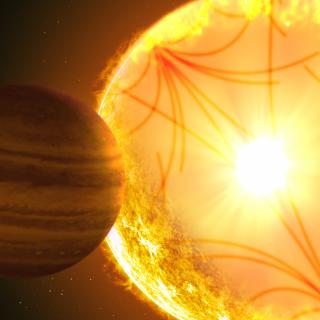Bibcode
Almenara, J. M.; Deeg, H. J.; Aigrain, S.; Alonso, R.; Auvergne, M.; Baglin, A.; Barbieri, M.; Barge, P.; Bordé, P.; Bouchy, F.; Bruntt, H.; Cabrera, J.; Carone, L.; Carpano, S.; Catala, C.; Csizmadia, Sz.; de La Reza, R.; Deleuil, M.; Dvorak, R.; Erikson, A.; Fridlund, M.; Gandolfi, D.; Gillon, M.; Gondoin, P.; Guenther, E.; Guillot, T.; Hatzes, A.; Hébrard, G.; Jorda, L.; Lammer, H.; Léger, A.; Llebaria, A.; Loeillet, B.; Magain, P.; Mayor, M.; Mazeh, T.; Moutou, C.; Ollivier, M.; Pätzold, M.; Pont, F.; Queloz, D.; Rauer, H.; Régulo, C.; Renner, S.; Rouan, D.; Samuel, B.; Schneider, J.; Shporer, A.; Wuchterl, G.; Zucker, S.
Referencia bibliográfica
Astronomy and Astrophysics, Volume 506, Issue 1, 2009, pp.337-341
Fecha de publicación:
10
2009
Revista
Número de citas
49
Número de citas referidas
41
Descripción
Context: The CoRoT satellite searches for planets by applying the
transit method, monitoring up to 12 000 stars in the galactic plane for
150 days in each observing run. This search is contaminated by a large
fraction of false positives, caused by different eclipsing binary
configurations that might be confused with a transiting planet. Aims: We evaluate the rates and nature of false positives in the CoRoT
exoplanets search and compare our results with semiempirical
predictions. Methods: We consider the detected binary and planet
candidates in the first three extended CoRoT runs, and classify the
results of the follow-up observations completed to verify their
planetary nature. We group the follow-up results into undiluted
binaries, diluted binaries, and planets and compare their abundances
with predictions from the literature. Results: 83% of the initial
detections are classified as false positives using only the CoRoT
light-curves, the remaining 17% require follow-up observations. Finally,
12% of the candidates in the follow-up program are planets. The shape of
the overall distribution of the false positive rate follows previous
predictions, except for candidates with transit depths below about 0.4%.
For candidates with transit depths in the range from 0.1-0.4%, CoRoT
detections are nearly complete, and this difference from predictions is
probably real and dominated by a lower than expected abundance of
diluted eclipsing binaries.
The CoRoT space mission, launched on December 27th 2006, has been
developed and is operated by CNES, with the contribution of Austria,
Belgium, Brazil , ESA (RSSD and Science Programme), Germany and Spain.
Proyectos relacionados

Sismología Solar y Estelar y Búsqueda de Exoplanetas
Los objetivos genéricos de este Proyecto son: 1) el estudio de la estructura y dinámica del interior solar, 2) la extensión de dicho estudio al caso de otras estrellas, 3) la búsqueda y caracterización de planetas extrasolares por métodos fotométricos (principalmente mediante el método de tránsitos) y espectroscópico (variaciones en la velocidad
Savita
Mathur